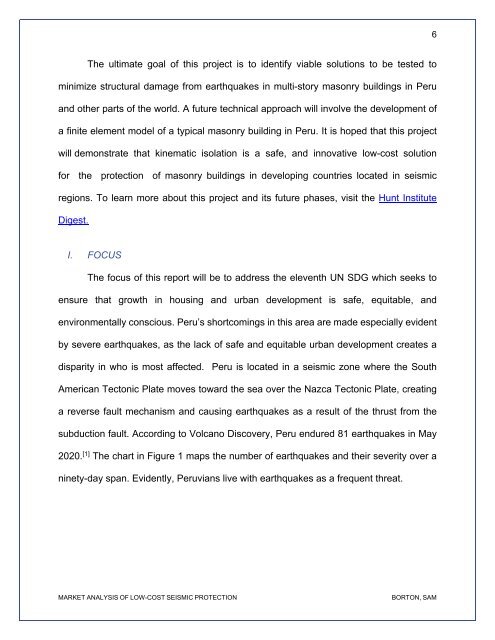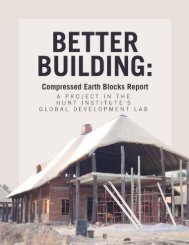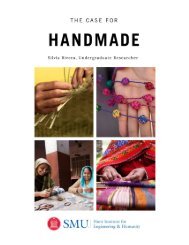Seeking Low-Cost Seismic Protection for Urban Masonry in an Unstable Terrain
Earthquakes pose a significant threat to housing in developing countries. The citizens of these countries often lack the financial means to sufficiently protect their homes against seismic actions. In accordance with the eleventh UN Sustainable Development Goal (SDG), steps need to be taken to protect these vulnerable populations from the looming possibility of a severe earthquake. Specifically, the geographic location of Peru designates it as an especially earthquake-prone country, and many of its citizens cannot afford seismic reinforcement for their homes. Middle-class, urban residents, such as those in Lima, Peru often reside in informally constructed confined masonry houses which, in the case of a severe earthquake, would likely suffer significant damage or even collapse. For this reason, the seismic protection market is increasingly narrowing its focus to low-cost solutions. This report summarizes the existing low-cost propositions and discusses to what extent they would provide a feasible option for the aforementioned target population in Peru. Finding that even these “low-cost” solutions are out of reach for most of the middle-class residents of Lima, this report makes an alternate proposition. Rocking isolation offers great potential as an innovative and economical seismic protection alternative, but it has yet to be implemented as low-cost housing reinforcement. This emerging system of seismic protection could fill a gap in the market as it may provide a sufficiently low-cost accessible manner of protecting confined masonry homes.
Earthquakes pose a significant threat to housing in developing countries. The citizens of these countries often lack the financial means to sufficiently protect their homes against seismic actions. In accordance with the eleventh UN Sustainable Development Goal (SDG), steps need to be taken to protect these vulnerable populations from the looming possibility of a severe earthquake. Specifically, the geographic location of Peru designates it as an especially earthquake-prone country, and many of its citizens cannot afford seismic reinforcement for their homes. Middle-class, urban residents, such as those in Lima, Peru often reside in informally constructed confined masonry houses which, in the case of a severe earthquake, would likely suffer significant damage or even collapse. For this reason, the seismic protection market is increasingly narrowing its focus to low-cost solutions.
This report summarizes the existing low-cost propositions and discusses to what extent they would provide a feasible option for the aforementioned target population in Peru. Finding that even these “low-cost” solutions are out of reach for most of the middle-class residents of Lima, this report makes an alternate proposition. Rocking isolation offers great potential as an innovative and economical seismic protection alternative, but it has yet to be implemented as low-cost housing reinforcement. This emerging system of seismic protection could fill a gap in the market as it may provide a sufficiently low-cost accessible manner of protecting confined masonry homes.
You also want an ePaper? Increase the reach of your titles
YUMPU automatically turns print PDFs into web optimized ePapers that Google loves.
6<br />
The ultimate goal of this project is to identify viable solutions to be tested to<br />
m<strong>in</strong>imize structural damage from earthquakes <strong>in</strong> multi-story masonry build<strong>in</strong>gs <strong>in</strong> Peru<br />
<strong>an</strong>d other parts of the world. A future technical approach will <strong>in</strong>volve the development of<br />
a f<strong>in</strong>ite element model of a typical masonry build<strong>in</strong>g <strong>in</strong> Peru. It is hoped that this project<br />
will demonstrate that k<strong>in</strong>ematic isolation is a safe, <strong>an</strong>d <strong>in</strong>novative low-cost solution<br />
<strong>for</strong> the protection of masonry build<strong>in</strong>gs <strong>in</strong> develop<strong>in</strong>g countries located <strong>in</strong> seismic<br />
regions. To learn more about this project <strong>an</strong>d its future phases, visit the Hunt Institute<br />
Digest.<br />
I. FOCUS<br />
The focus of this report will be to address the eleventh UN SDG which seeks to<br />
ensure that growth <strong>in</strong> hous<strong>in</strong>g <strong>an</strong>d urb<strong>an</strong> development is safe, equitable, <strong>an</strong>d<br />
environmentally conscious. Peru’s shortcom<strong>in</strong>gs <strong>in</strong> this area are made especially evident<br />
by severe earthquakes, as the lack of safe <strong>an</strong>d equitable urb<strong>an</strong> development creates a<br />
disparity <strong>in</strong> who is most affected. Peru is located <strong>in</strong> a seismic zone where the South<br />
Americ<strong>an</strong> Tectonic Plate moves toward the sea over the Nazca Tectonic Plate, creat<strong>in</strong>g<br />
a reverse fault mech<strong>an</strong>ism <strong>an</strong>d caus<strong>in</strong>g earthquakes as a result of the thrust from the<br />
subduction fault. Accord<strong>in</strong>g to Volc<strong>an</strong>o Discovery, Peru endured 81 earthquakes <strong>in</strong> May<br />
2020. [1] The chart <strong>in</strong> Figure 1 maps the number of earthquakes <strong>an</strong>d their severity over a<br />
n<strong>in</strong>ety-day sp<strong>an</strong>. Evidently, Peruvi<strong>an</strong>s live with earthquakes as a frequent threat.<br />
MARKET ANALYSIS OF LOW-COST SEISMIC PROTECTION<br />
BORTON, SAM













